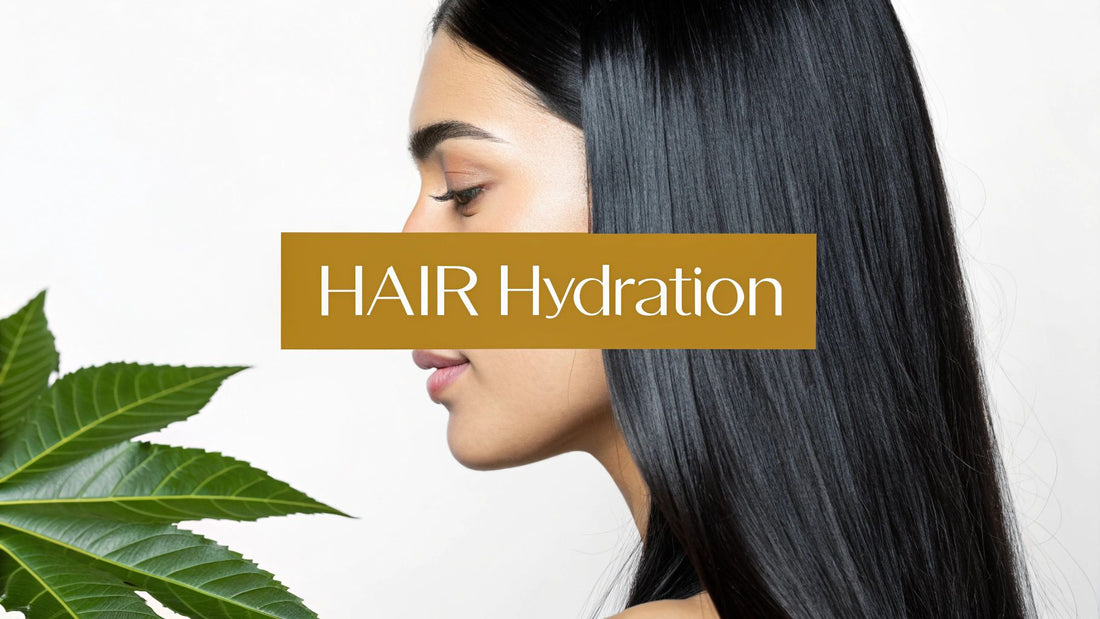
Unlock Your Hair's True Potential: The Definitive Guide to Castor Oil Benefits
Share
Let’s cut through the noise. When it comes to castor oil, the real magic isn't in some mythical growth promise. It's all about creating the ultimate foundation for healthy hair through unparalleled moisture and scalp care. Think of it as transforming your scalp into the perfect garden for your hair to grow—it won't make the plants sprout overnight, but it nourishes the soil so they can truly flourish.
What Are the Real Benefits of Castor Oil for Hair
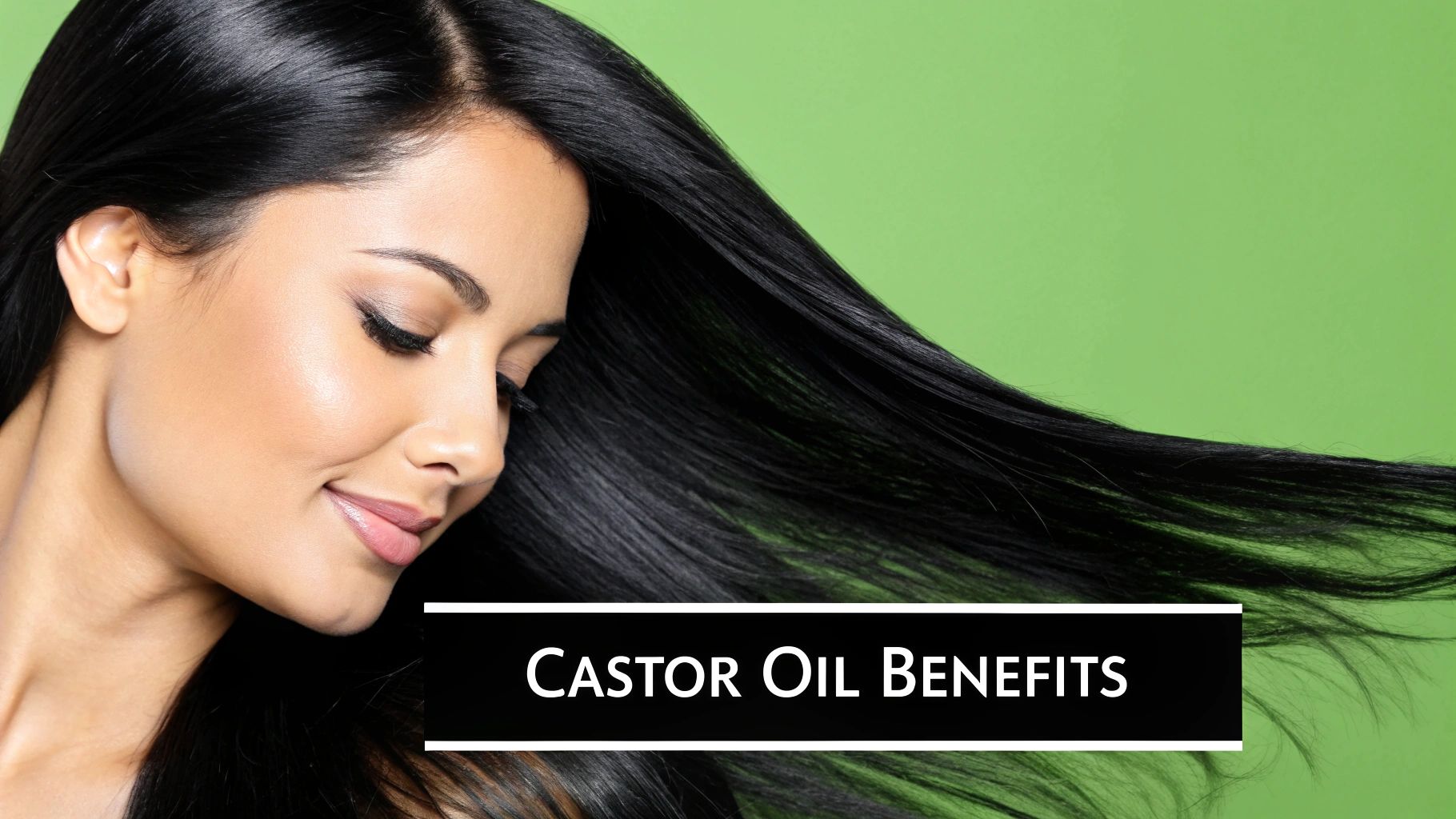
So, is all the buzz around castor oil actually worth it? The answer is a resounding yes, but you must understand its true purpose. It's time to shift our perspective from a miracle growth formula to a foundational treatment that builds undeniably stronger, healthier hair from the ground up.
Castor oil's true power lies in creating an ideal environment for your hair. Its uniquely thick, rich texture coats each individual strand, sealing in precious moisture and making your hair remarkably more flexible. This elasticity is a complete game-changer because it prevents the snapping and splitting that hold you back from your length goals. When you minimize breakage, you keep the hair you've worked so hard to grow, which makes it look and feel like it's growing faster and healthier than ever before.
This isn't a fleeting trend; this oil has been a staple in traditional wellness for centuries. Its secret is a unique chemical profile dominated by about 90% ricinoleic acid. This fatty acid is a powerhouse, celebrated for its incredible moisturizing and anti-inflammatory abilities that are perfect for cultivating a happy, healthy scalp.
To give you a crystal-clear picture, let's break down exactly what castor oil brings to the table.
Castor Oil's Core Hair Benefits at a Glance
| Benefit | How It Works | Primary Outcome |
|---|---|---|
| Intense Moisturization | A natural humectant that draws moisture into the hair and scalp, sealing it in. | Luxuriously soft, supple hair that feels deeply hydrated and healthy. |
| Reduced Breakage | Improves hair elasticity, making strands more flexible and far less likely to snap. | Superior length retention and visibly fuller-looking hair. |
| Enhanced Shine | Smoothes the hair cuticle, allowing it to reflect more light for a brilliant, glossy finish. | Naturally shiny, vibrant-looking hair that radiates health. |
| Soothed Scalp | Anti-inflammatory properties calm irritation, eliminate flakiness, and balance dryness. | A perfectly balanced scalp environment that supports thriving hair follicles. |
Ultimately, these benefits work in synergy to create hair that is fundamentally stronger and more resilient.
Strengthening Hair From the Inside Out
A healthy scalp is the absolute bedrock of great hair, and this is where castor oil truly gets to work. Its potent natural anti-inflammatory properties help to calm the irritation, itchiness, and dryness that disrupt your hair follicles and stand in the way of healthy growth.
By focusing on scalp health and deep hydration, castor oil empowers you to build hair that is resilient, shiny, and less susceptible to daily wear and tear. It’s a proactive, not reactive, approach to achieving the hair you've always wanted.
The goal isn't just about looks; it's about building hair that can handle daily styling, environmental factors, and life in general. To learn more about how it all works, you can explore our in-depth post asking, is castor oil good for hair?
How Castor Oil Actually Works for Your Hair
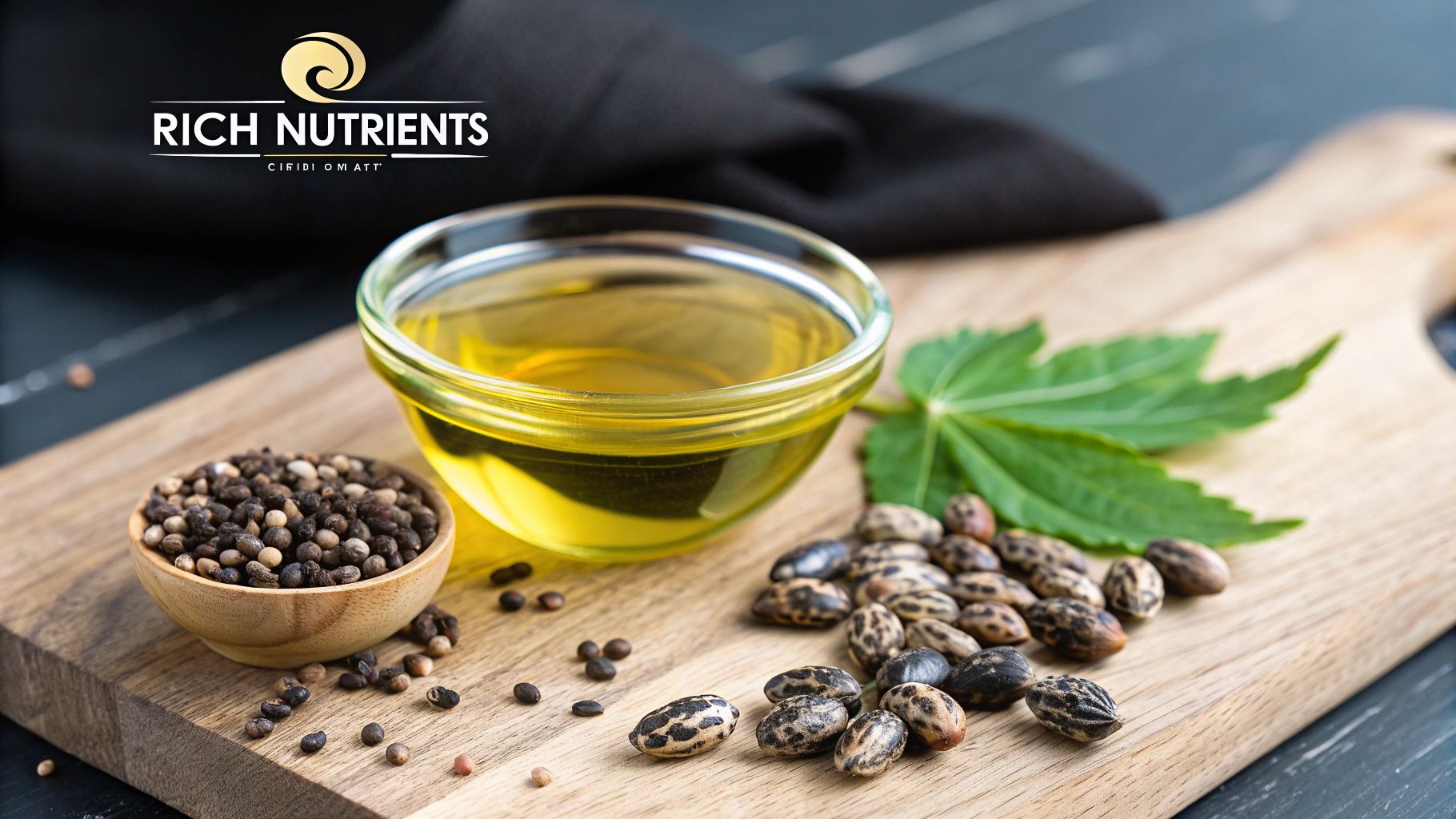
To truly grasp why castor oil is so revered for hair, you need to understand what it’s actually doing at a molecular level. This isn’t magic—it’s pure science, and the hero of the story is ricinoleic acid.
This unique omega-9 fatty acid makes up an astounding 90% of castor oil, and it’s the secret behind most of its powerful benefits.
Picture each strand of your hair as a delicate rope made of tiny fibers, all protected by an outer layer called the cuticle. Everyday life—brushing, blow-drying, even sun exposure—roughs up that cuticle, leaving it frayed. This damage allows precious moisture to escape, which is precisely why your hair feels dry, brittle, and snaps so easily.
This is where castor oil intervenes. Thanks to ricinoleic acid, it acts as both a powerful softener (an emollient) and a moisture-sealer (a humectant). I like to think of it like applying a high-quality sealant to a wooden deck. It doesn't just sit on top; it sinks in to nourish the wood while creating a robust barrier that protects it from the elements.
By coating the hair shaft, castor oil smooths down those ruffled cuticle scales. This one action locks in moisture, making each strand far more flexible and dramatically less prone to breaking.
The Science of Strength and Shine
When your hair's cuticle is sealed and properly moisturized, you get two fantastic results almost immediately.
First, your hair becomes stronger and more elastic. It has more give. So, when you pull it back into a ponytail or run a brush through it, it’s far less likely to snap. This is essential for anyone trying to grow their hair out, because less breakage means you finally get to keep the length you gain.
Second, a smooth, flat cuticle reflects light much more evenly. This is what creates that beautiful, healthy-looking gloss. It's not an artificial shine from a silicone-based product; it's your hair’s natural brilliance, amplified because its surface is in optimal condition.
Castor oil's primary job is to protect and fortify the hair you already have. By reducing the daily wear and tear, it builds a foundation for stronger strands that can finally reach their full, healthy potential.
This protective quality is one of the most significant benefits people report when they use castor oil. It’s what helps turn weak, fragile hair into something that feels and looks undeniably more resilient.
Calming the Scalp for Healthier Follicles
But the benefits don't stop with your hair strands. Let’s be honest: you can't have healthy hair without a healthy scalp. If your scalp is itchy, inflamed, or perpetually dry, it creates a stressful environment that is terrible for growing strong hair.
This is another area where ricinoleic acid proves its worth. It possesses seriously impressive anti-inflammatory properties. When you massage castor oil into your scalp, it acts like a soothing balm. It can help calm redness, ease that frustrating itch, and combat the flakiness that comes with a dry scalp.
On top of that, castor oil also has antimicrobial properties. This means it can help keep bad bacteria and fungi in check, promoting a clean, balanced environment for your hair follicles. By creating these ideal conditions right at the root, you're giving your hair its absolute best shot at growing in healthy and strong from the very beginning.
Why People Around the World Trust Castor Oil
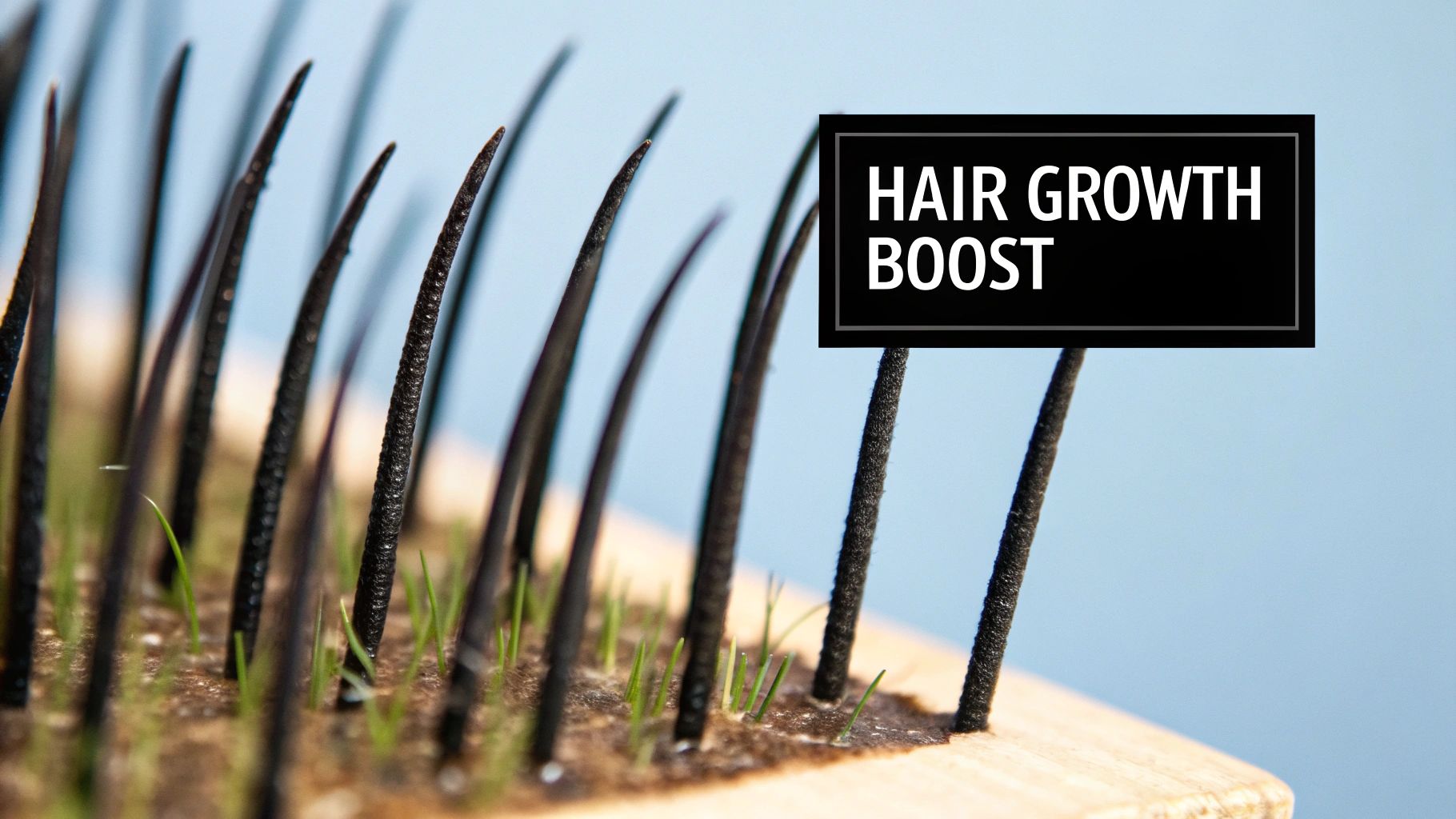
The buzz you see about castor oil online isn't some fleeting social media trend. It’s the modern chapter of a story that goes back centuries, a trusted tradition that has spanned the globe. This isn't just another product—it's a time-tested ritual for millions.
For generations, families everywhere from India to Brazil and across the Caribbean have reached for castor oil as their go-to hair remedy. It’s the kind of sacred knowledge passed down from mothers to daughters, celebrated for its remarkable ability to add shine, calm an itchy scalp, and fortify hair against breakage.
A Legacy of Proven Results
This long history across countless cultures and hair types is powerful proof of its efficacy. Let's be real: a remedy doesn't stick around for centuries if it doesn't deliver results.
The trust people place in castor oil is built on something solid: real, visible outcomes. Generation after generation has relied on it simply because they’ve seen it work with their own eyes. We're not just talking about a few anecdotes; it's a shared global experience that all points to the same undeniable conclusion.
The global embrace of castor oil isn’t based on marketing hype, but on a long-standing legacy of trust. Its staying power in hair care routines around the world is one of the strongest testaments to its reliable benefits for hair and scalp health.
And this widespread cultural love for castor oil has a huge economic impact, proving it’s a powerhouse well beyond our bathroom cabinets.
More Than Just a Home Remedy
Commercially, castor oil is a massive player in the global hair care market, especially in regions where the Ricinus communis plant thrives. India, for example, produces about 85% of the entire world's castor oil supply, which highlights just how vital it is culturally and economically.
Market data confirms this. Hair products featuring castor oil consistently score high in user satisfaction, often hitting a 70-80% approval rating for improving shine and soothing scalp dryness. You can dig into these market findings on NCBI if you're curious.
So, when you reach for a bottle of castor oil, you’re not just buying a product. You're tapping into a solution that people worldwide have trusted for ages to achieve healthier, shinier, and more resilient hair. It’s a simple, natural ingredient that has truly stood the test of time.
How to Apply Castor Oil for the Best Results
So, you're ready to give castor oil a try? Let's walk through how to do it right. The first thing you’ll notice is that castor oil is incredibly thick and sticky. If you try to apply it straight from the bottle, you'll likely end up with a frustrating, uneven mess.
The secret from people who’ve been using it for years is to thin it out a bit. Think of it like diluting a super-concentrated juice. A brilliant way to do this is by mixing it with a lighter carrier oil, like coconut, jojoba, or argan oil. A simple 1:1 ratio usually does the trick, creating a much smoother blend that’s easier to spread and won't weigh your hair down.
Here’s another pro tip: gently warm the oil mixture before you use it. Just place your bowl of oil in a larger bowl of warm water for a few minutes. This simple step makes the oil less viscous, helping it sink into your hair and scalp much more effectively.
A Simple Step-by-Step Application Guide
To get the most out of your treatment, you must be methodical. Rushing it just means you'll miss spots and won't get the even coverage you need for transformative results.
-
Section Your Hair: Start with dry or slightly damp hair. Part it into at least four sections and clip them up. Working one section at a time is the only way to ensure every strand gets the attention it deserves.
-
Focus on the Scalp: Dip your fingertips into your warm oil blend and start massaging it directly onto your scalp. Use gentle, circular motions. This feels incredible, but more importantly, it helps boost circulation to your hair follicles, which is where growth begins.
-
Coat Your Strands: Once your scalp is covered, work the leftover oil down the length of your hair. Give your ends extra attention—they're the oldest and most fragile part of your hair and desperately need that moisture to fend off split ends.
This is what's happening on a microscopic level. The oil penetrates the hair shaft, locking in moisture and making your hair more flexible and resilient.
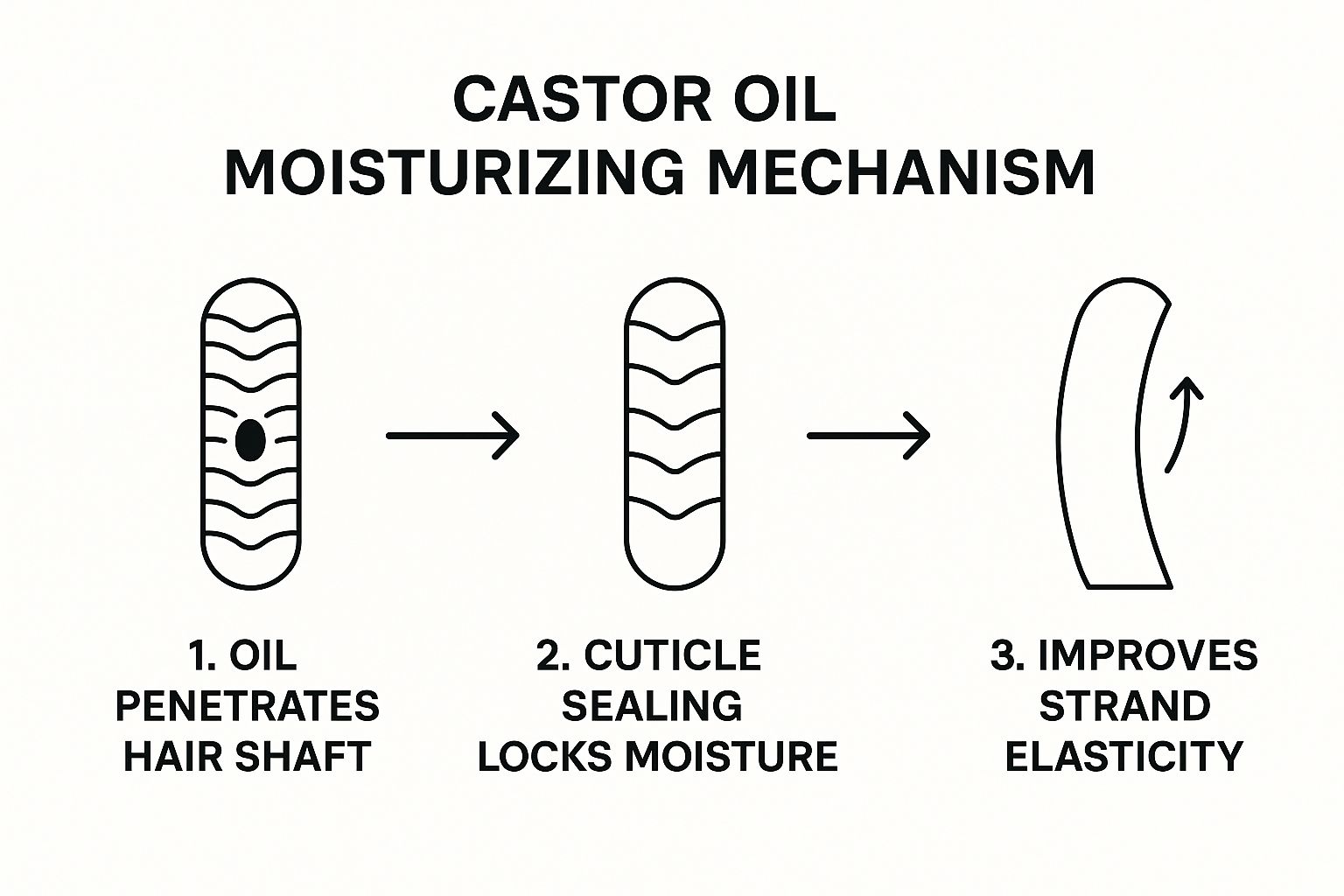
The goal isn't just to coat your hair in oil, but to let it soak in deep down to build strength from the inside out.
Your application technique can change slightly depending on what you're trying to achieve. Here’s a quick breakdown:
Castor Oil Application Methods for Different Hair Goals
| Hair Goal | Application Technique | Frequency |
|---|---|---|
| Scalp Health & Growth | Focus the massage on the scalp, using fingertips to stimulate follicles. Use a smaller amount of oil. | 1-2 times per week |
| Reduce Breakage | Concentrate on the mid-lengths and ends, gently scrunching oil into the most fragile parts. | 1 time per week |
| Improve Shine | Lightly glaze the surface of the hair from roots to ends after massaging the scalp. | As needed, or 1-2 times per month |
Ultimately, whether you're targeting your scalp or your ends, a consistent and targeted approach will give you the best results.
How Long Should You Leave It In?
This really depends on your hair's condition and how much time you have. The good news is, you've got options.
-
Quick Boost (30-60 Minutes): If you're pressed for time, even a 30-minute treatment can give your hair a noticeable dose of moisture and shine. Pop on a shower cap to trap your body heat, which helps the oil penetrate better.
-
Deep Treatment (2-4 Hours): For a more intensive conditioning, let the oil sit for a couple of hours. This gives it plenty of time to work its way into the hair cuticle for a profound conditioning effect.
-
Overnight Mask (Maximum Hydration): If your hair is particularly dry or damaged, an overnight treatment can be a total game-changer. Just apply the oil before bed, wrap your hair in a silk scarf or cap (to save your pillowcase!), and wash it out in the morning.
No matter how long you leave it in, washing it out properly is paramount. You’ll probably need to shampoo twice, really focusing on your scalp to lift all the oil. This step is crucial for avoiding greasy roots and ensuring you’re left with soft, nourished hair, not an oily scalp.
Walking down the hair care aisle can be overwhelming, I get it. But when it comes to picking the right castor oil, it’s actually simple once you know what to look for. Not all castor oils are created equal, and the secret to getting those amazing results is choosing the one that aligns with your hair's unique personality.
The biggest difference between the types of castor oil you'll see on the shelf boils down to their production method. This process completely changes the oil's properties, making each one a better fit for different hair goals. Let's break down the most common options so you can choose with confidence.
Cold-Pressed Castor Oil: The Pure All-Rounder
Think of cold-pressed castor oil as the most natural, untouched version you can get. It's extracted straight from castor beans using only mechanical pressure—no heat involved. This gentle process is crucial because it keeps all the beneficial compounds, like the powerhouse ricinoleic acid, perfectly intact and at their most potent.
Because it's so pure and minimally processed, cold-pressed castor oil is a fantastic all-purpose choice for just about anyone.
- Best for: Fine to medium hair, since it’s a bit lighter and less dense than other types.
- Ideal for: Sensitive scalps. With no processing residues or additives, the risk of irritation is incredibly low.
- Perfect as: A base oil. It mixes beautifully with lighter oils like jojoba or almond for a custom hair treatment.
If you're looking for a high-quality, pure option, an organic cold-pressed castor oil is an excellent place to start your hair care journey.
Jamaican Black Castor Oil: The Moisture Magnet
Jamaican Black Castor Oil, often called JBCO, has a signature dark color and a richer, earthier smell that comes from its traditional production method. First, the castor beans are roasted. Then, they're boiled down to extract the oil. A key part of this process is that the ash from the roasting step actually makes it into the final product.
That ash content makes JBCO more alkaline than its cold-pressed cousin. This higher pH is what people believe helps gently open up the hair's cuticle—the protective outer layer of each strand.
By opening the cuticle, Jamaican Black Castor Oil allows moisture to penetrate much deeper. This makes it a holy grail for hair types that are constantly fighting off dryness.
It's a game-changer for:
- Thick, coarse, or curly hair: These hair types often struggle to absorb moisture, and JBCO delivers hydration right where it's needed most.
- Low-porosity hair: If your hair seems to resist water and products, JBCO's ability to lift the cuticle can make a huge difference.
- Strengthening treatments: Its thick, rich consistency is perfect for sealing split ends and stopping breakage in its tracks.
Ultimately, choosing between them isn’t about which one is "better" overall, but which one is better for you. When you match the oil's properties to what your hair truly needs, you’re setting yourself up for success.
How to Use Castor Oil Safely (And Avoid Side Effects)
To get the most out of castor oil, you must know how to use it correctly. It's incredibly safe for almost everyone, but a little know-how goes a long way in making sure your experience is a great one. Think of this as your user's manual for happy, healthy hair.
The absolute golden rule? Always, always do a patch test first. Seriously, do not skip this. It's like dipping your toe in the pool before you dive in—it just makes sense.
How to Do a Quick Patch Test
A patch test is your best friend for verifying how your skin will react. It’s incredibly simple and gives you total peace of mind.
- Dab a small drop of castor oil on a hidden spot, like the inside of your wrist or behind your ear.
- Leave it alone for 24 hours. Don't wash it off.
- After a day, check the spot. Is there any sign of redness, itching, or swelling?
If your skin is perfectly calm and happy, you're cleared for takeoff! This one tiny step ensures you can move forward with confidence.
Now, let's talk about skin types. While castor oil is a champion at fighting bacteria, its thick, heavy texture can be tricky for some. If your skin is prone to breakouts, you'll want to be mindful, as heavy oils can sometimes lead to clogged pores. We dive deeper into this in our guide on using castor oil for skin care.
Finally, let's address a very rare but real concern: hair felting. This is when hair becomes hopelessly matted, almost like felt. It’s an extremely uncommon issue, usually tied to using far too much thick, undiluted oil and leaving it in for far too long. The easy fix? Use it as a pre-shampoo treatment in moderation, and you'll never have to worry about it.
Knowing these simple ground rules allows you to use castor oil without any worry. You're simply taking smart steps to protect your hair and scalp while letting the oil work its magic.
Got Questions About Castor Oil? Let's Clear Things Up.
Even after learning all the good stuff, you probably still have a few questions rolling around in your head. That's completely normal! Let's tackle some of the most common ones so you can feel completely confident about using castor oil in your routine.
Can Castor Oil Actually Make My Hair Grow Faster?
This is the million-dollar question, isn't it? The straightforward answer is no, castor oil will not directly speed up the rate at which your hair grows from the follicle. Science has not backed that claim.
What it excels at is protecting the hair you already have. Think of it as a bodyguard for your hair strands. By coating your hair, moisturizing it, and making it more flexible, castor oil dramatically cuts down on breakage. As a result, you get to keep the length you grow, which makes it seem like your hair is growing faster and healthier over time.
How Often Should I Be Using It?
When it comes to castor oil, consistency is key, but you can definitely have too much of a good thing. The perfect schedule really boils down to your specific hair type.
- For most hair types: A pre-shampoo treatment once or twice a week is the ideal sweet spot.
- For very dry or thick hair: You might find your hair loves the extra moisture from two treatments per week.
- For fine or oily hair: Start with once a week, or perhaps even every other week, to avoid weighing down your strands.
Is Jamaican Black Castor Oil Better Than the Regular Kind?
One isn't "better" than the other; they simply do different jobs. It’s like asking if a hammer is better than a screwdriver—it depends on what you’re trying to build!
Cold-pressed castor oil is pure and potent, making it a fantastic all-around option, especially if you have finer hair or a sensitive scalp. On the other hand, Jamaican Black Castor Oil (JBCO) is more alkaline because the beans are roasted. This slightly higher pH helps open up the hair's cuticle, making it a hero for thick, coily, or low-porosity hair that struggles to soak up moisture.
The right choice is all about your hair's unique personality. If your hair fights moisture, give JBCO a try. If you want a pure, gentle starting point, stick with cold-pressed.
Will This Stuff Make My Hair a Greasy Mess?
Oh, it absolutely can if you're not careful! Castor oil is incredibly thick and heavy, so a little bit goes a very, very long way. Using too much or not washing it out properly is a one-way ticket to an oil slick.
The secret to avoiding this is to mix it with a lighter carrier oil (like jojoba or coconut) and apply it sparingly. When it's time to wash, you'll likely need to shampoo twice. Really focus on massaging the shampoo into your scalp to break down and lift all the oil. This simple trick leaves you with soft, nourished hair instead of a greasy residue.
Ready to feel the strengthening and moisturizing magic of pure castor oil for yourself? terravera offers our Niya Organic Cold-Pressed Castor Oil, which is perfect for building shiny, resilient hair. Discover the difference on our website.
Article created using Outrank
